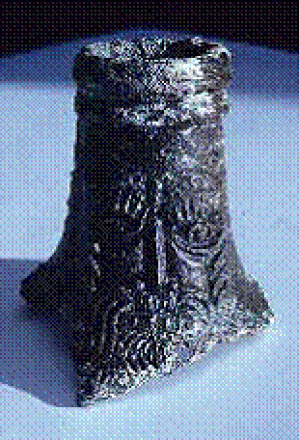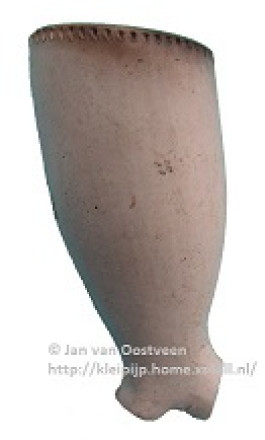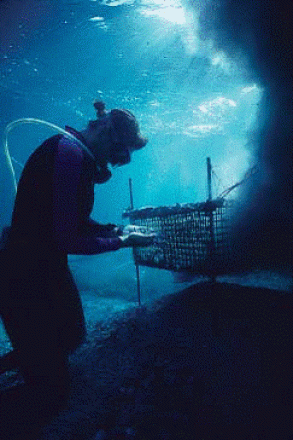History
Discovery
In 1966, a shipwreck was discovered in a bed of seagrass in Monte Cristi Bay in the Dominican Republic. The wreck is often called the 'pipe wreck' because of the great amount of clay pipes that were found there. The site appears to have been well known among locals and inhabitants of the Dominican Republic for a long time. Since 1966 the site, lying at a mere 4.4 meters depth, has repeatedly been visited by treasure hunters and souvenir collectors. Its history of salvage is however thought to extend back centuries. When archaeologists of the Monte Cristi Shipwreck Project arrived at the site in 1991, the obvious question was whether or not there was sufficient archaeological data left to accurately interpret the site.
At that time, the visible portion of the site is comprised of scattered ballast stones, ceramic sherds, concreted fragments of iron cooking cauldrons, and an estimated 500.000 smoking pipes, which had given the wreck its popular name. Careful study of these artefacts led to the hypothesis that the remains are of an inbound Dutch merchant vessel that was wrecked in the middle of the 17th century. The results of many years of excavation, historical research and analysis of artefacts carried out since then support this idea, which would make the wreck one of the few known Dutch shipwrecks in the New World.

Trade goods
Despite possibly centuries of salvage, and although the Pipe Wreck has still not yet been fully excavated, the remnants of its cargo make it clear that it is one of the largest and most diverse cargoes of any inbound merchantman destined for the Americas ever found. Around 10.000 mostly uniform pipes have been collected at the site, representing the largest aggregation of smoking-related artifacts ever recovered from a shipwreck, and possibly from any known archaeological site. Interestingly, a small portion of the collection consists of clear imitations of Native American ritual pipes, which uniquely shows how Dutch manufacturers responded to the indigenous market.
Combined with the ceramic finds, the typical Dutch cargo compares well with archaeological collections from upstate New York, and specifically the Dutch-American settlement at Fort Orange. This not only provides us with a likely origin of the ship, but also with a possible destination. Before sailing there, the vessel may first have ventured south in search of salt, leather and tobacco, all of which were abundant in 17th-century Hispaniola - as the Dominican Republic and Haiti were called back then. It may also have sought to trade contraband with the pirates and buccaneers common to the region in this period. Thus the Pipe wreck was clearly involved in triangular trade, a practice relatively few shipwrecks can provide information on. Before the ship could reach its destination, it is likely that an explosion put an end to its voyage, which is suggested by the large quantities of charred wood, melted metal and glass at the site.

Dutch pipes
Funnel type pipes make up 93% of the pipes excavated from the wreck. The funnel type of clay pipes was the successor of the the bi-conical type from the mid-17th century. The city of Gouda in Holland was the centre of the clay pipe industry, and the funnel type was most popular type between 1650 and 1740.


The ship and its sailors
Partially buried under the cargo and layers of concretion, a considerable part of the ship's hull has survived. Timber analysis suggests that the vessel was constructed in England sometime after 1642. It was also found that the hull had been coated with tar and cow hair, and covered with protective outer boards, a common 17th-century measure of protecting the ships hulls from biological degradation caused by shipworms and bacteria.
Aboard the ship, the sailors ate a reasonably varied diet of beef, pork, salted fish and conch, as indicated by organic remains. Olive pits and other fruit stones also regularly appeared in the sifted soil samples. It seems they may have had to compete with vermin for these foodstuffs, as evidenced by animal bones that bear rat incisor marks.

Description
Associated with: Dutch Republic, Fort Orange (Albany, NY), Dutch West India Company.

Status
Condition: (partly) preserved in situ, mobilia (largely) removed from context, published archaeological documentation available.
Institutions involved: Institute of Nautical Archaeology.
Even though the wreck site has been heavily disturbed over the course of the centuries, it has been found to contain sufficient data to effectively reconstruct the vessels construction, cargo, voyages and demise. Research of the wreck has thus made clear that not all disturbed archaeological sites should be viewed as worthless. Even so, measures have been taken to protect the tremendous research potential of the remainder of the Pipe wreck. Its timbers now lie buried beneath a protective covering of tarpaulins, sandbags and a meter-thick layer of sand and coral rubble. Also, the Monte Cristi Shipwreck Project team has invested significantly in raising awareness of the wrecks importance among local officials, fishing boat operators and tourist guides.

References
- D.H. Duco (Leiden, 1987), De Nederlandse kleipijp, handboek voor dateren en determineren.
- Hall, J. L. (2006).
The Monte Cristi Pipe Wreck.
Heritage at Risk. - Hall, J.L. (1996).
A 17th century Northern European Merchant Shipwreck in Monte Cristin Bay, Dominican Republic.
Texas A&M University. - Monte Cristi Shipwreck Excavation Site Plans and Drawings.
- Monte Cristi Shipwreck Excavation.